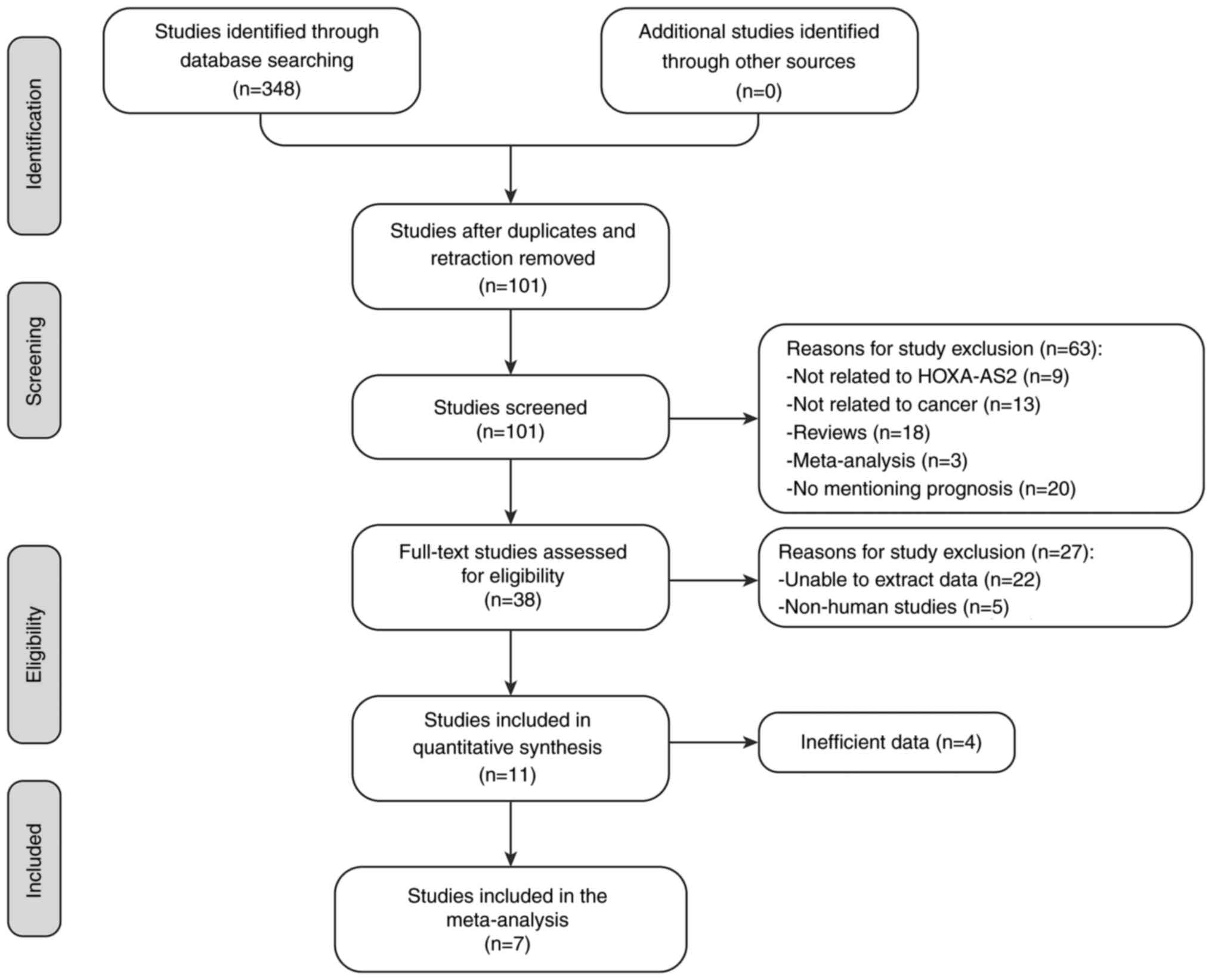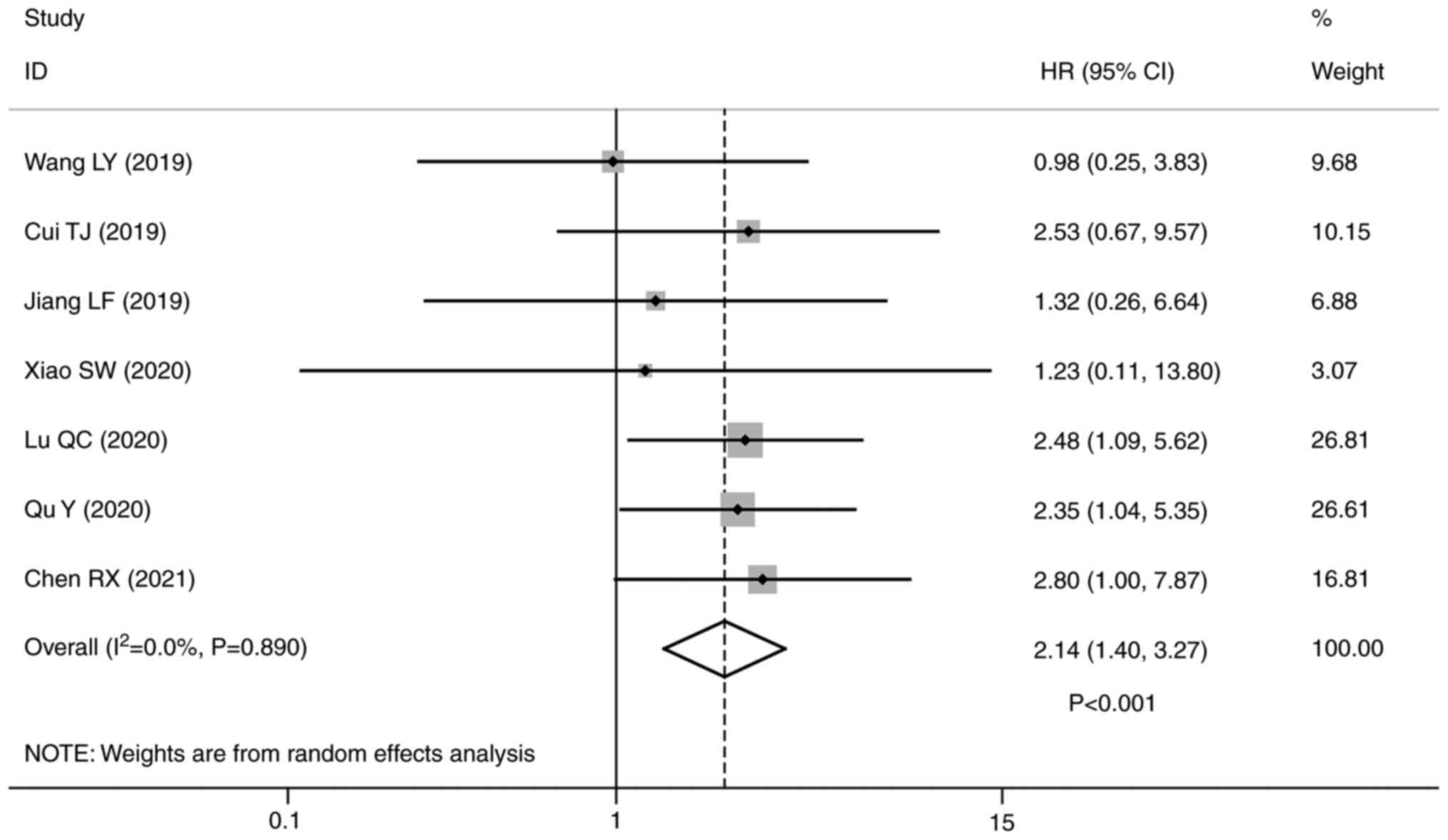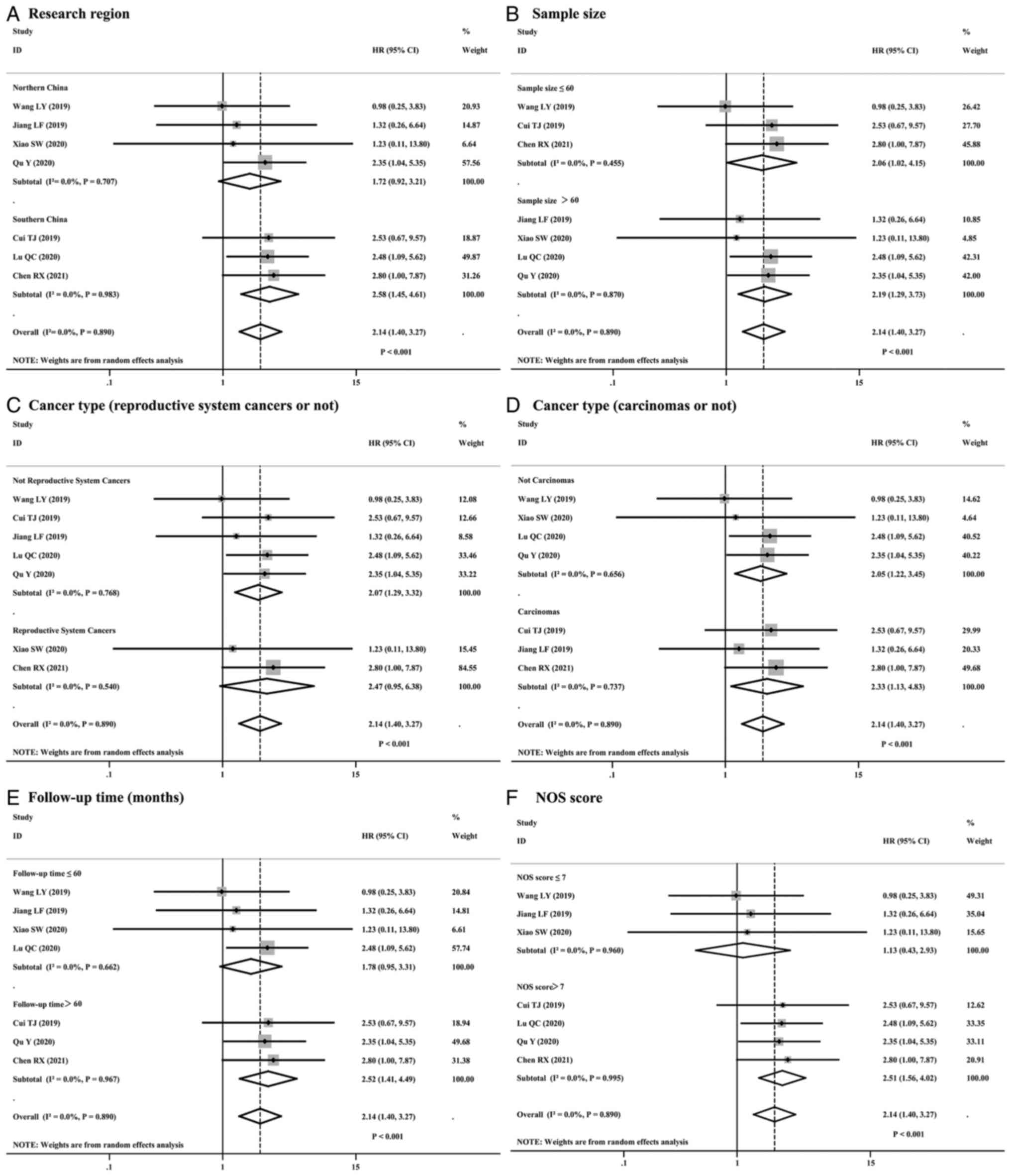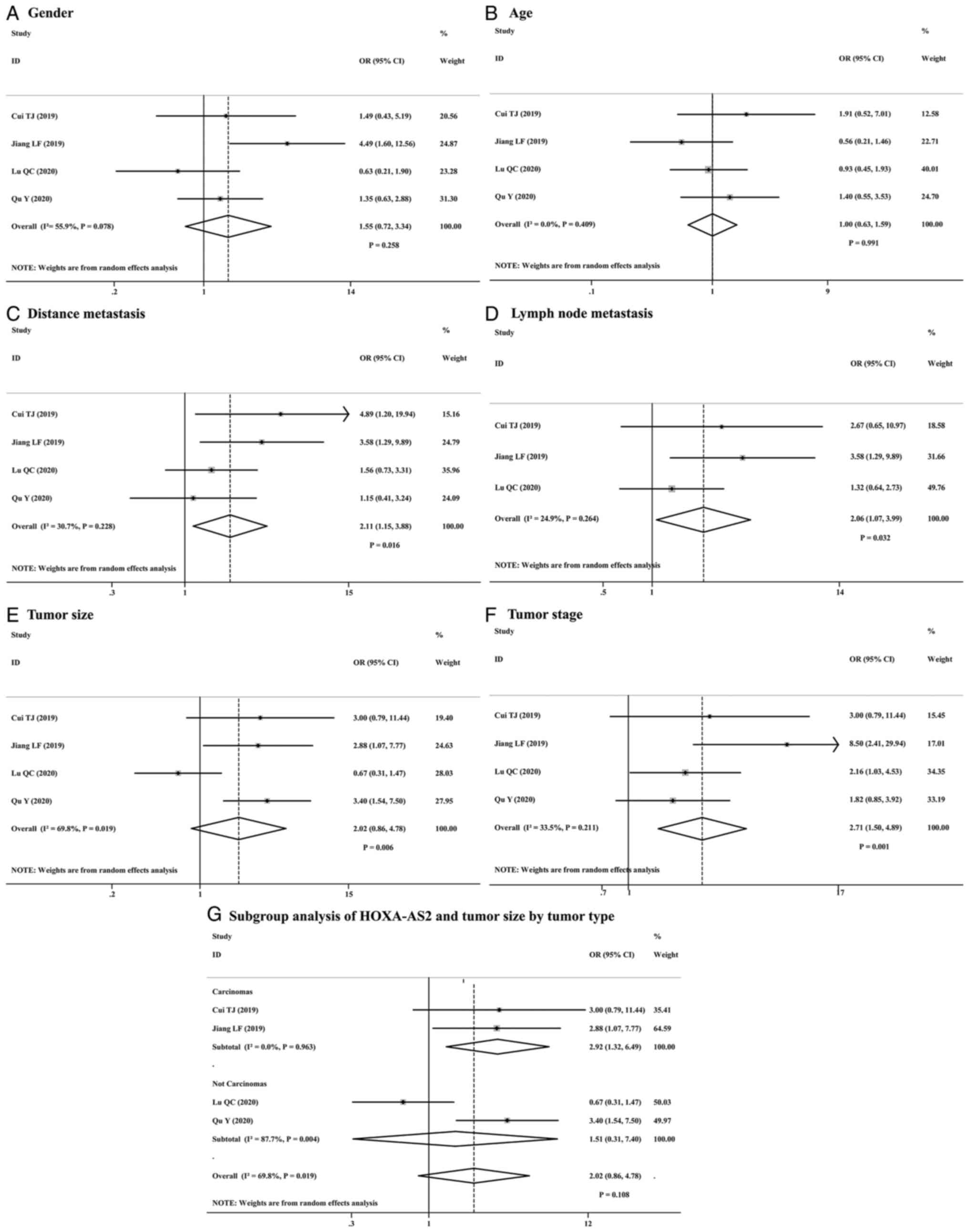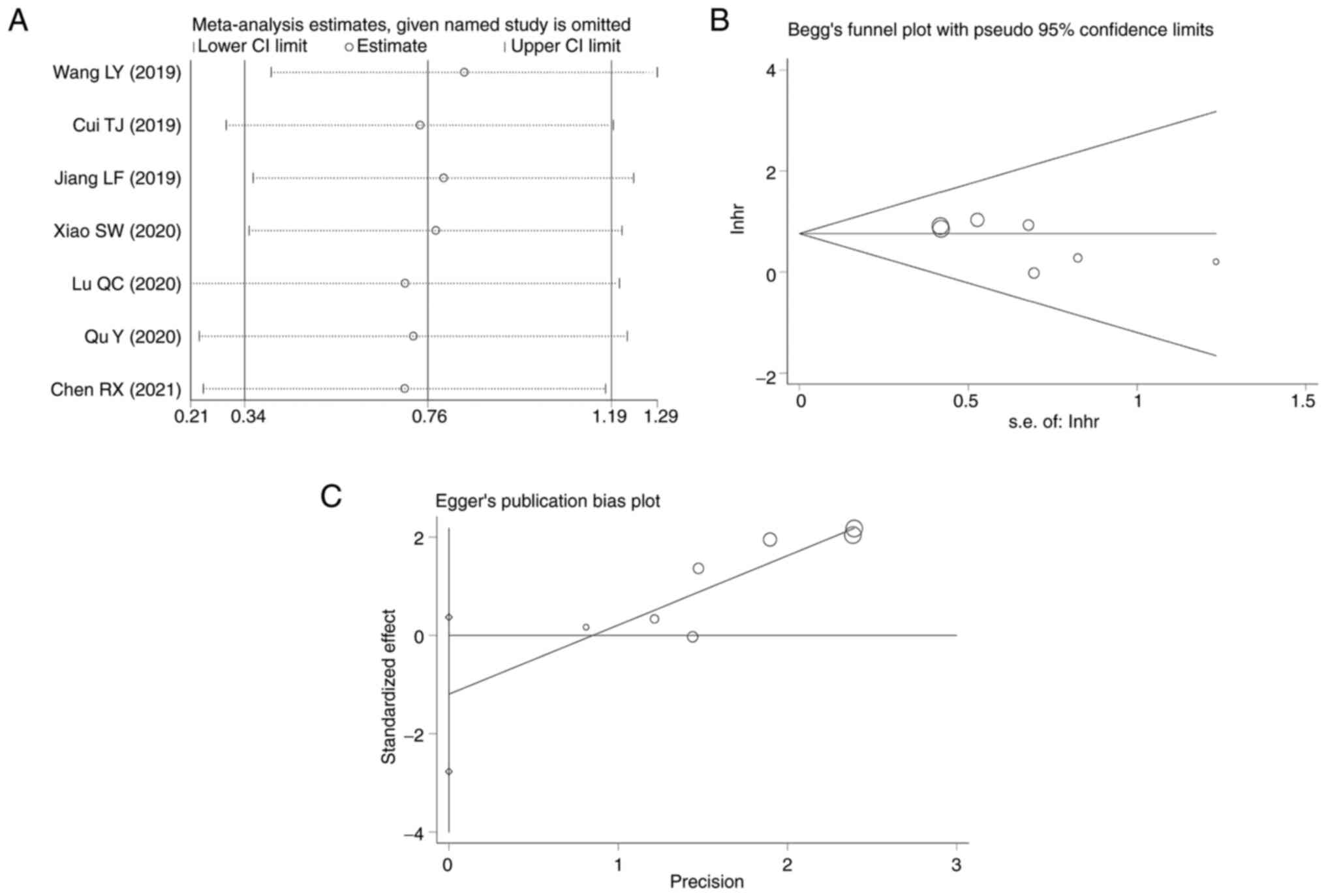|
1
|
Mattick JS and Makunin IV: Non-coding RNA.
Hum Mol Genet. 15:Spec No 1:R17–29. 2006. View Article : Google Scholar : PubMed/NCBI
|
|
2
|
Derrien T, Johnson R, Bussotti G, Tanzer
A, Djebali S, Tilgner H, Guernec G, Martin D, Merkel A, Knowles DG,
et al: The GENCODE v7 catalog of human long noncoding RNAs:
Analysis of their gene structure, evolution, and expression. Genome
Res. 22:1775–1789. 2012. View Article : Google Scholar : PubMed/NCBI
|
|
3
|
Kung JT, Colognori D and Lee JT: Long
noncoding RNAs: Past, present, and future. Genetics. 193:651–669.
2013. View Article : Google Scholar : PubMed/NCBI
|
|
4
|
Fatica A and Bozzoni I: Long non-coding
RNAs: New players in cell differentiation and development. Nat Rev
Genet. 15:7–21. 2014. View
Article : Google Scholar : PubMed/NCBI
|
|
5
|
Bhan A, Soleimani M and Mandal SS: Long
noncoding RNA and cancer: A new paradigm. Cancer Res. 77:3965–3981.
2017. View Article : Google Scholar : PubMed/NCBI
|
|
6
|
Wang KC and Chang HY: Molecular mechanisms
of long noncoding RNAs. Mol Cell. 43:904–914. 2011. View Article : Google Scholar : PubMed/NCBI
|
|
7
|
Schmitt AM and Chang HY: Long noncoding
RNAs in cancer pathways. Cancer Cell. 29:452–463. 2016. View Article : Google Scholar : PubMed/NCBI
|
|
8
|
Choudhari R, Sedano MJ, Harrison AL,
Subramani R, Lin KY, Ramos EI, Lakshmanaswamy R and Gadad SS: Long
noncoding RNAs in cancer: From discovery to therapeutic targets.
Adv Clin Chem. 95:105–147. 2020. View Article : Google Scholar : PubMed/NCBI
|
|
9
|
Zhao H, Zhang X, Frazão JB, Condino-Neto A
and Newburger PE: HOX antisense lincRNA HOXA-AS2 is an apoptosis
repressor in all trans retinoic acid treated NB4 promyelocytic
leukemia cells. J Cell Biochem. 114:2375–2383. 2013. View Article : Google Scholar : PubMed/NCBI
|
|
10
|
Feng Y, Hu S, Li L, Peng X and Chen F:
Long noncoding RNA HOXA-AS2 functions as an oncogene by binding to
EZH2 and suppressing LATS2 in acute myeloid leukemia (AML). Cell
Death Dis. 11:10252020. View Article : Google Scholar : PubMed/NCBI
|
|
11
|
Zhang P, Liu L, Zhang W, Fang J, Li G,
Zhang L, Li J, Deng X, Ma J, Li K and Chen Z: Effects of long
noncoding RNA HOXA-AS2 on the proliferation and migration of
gallbladder cancer cells. J Oncol. 2022:60515122022. View Article : Google Scholar : PubMed/NCBI
|
|
12
|
Zhong C, Tao B, Li X, Xiang W, Peng L,
Peng T, Chen L, Xia X, You J and Yang X: HOXA-AS2 contributes to
regulatory T cell proliferation and immune tolerance in glioma
through the miR-302a/KDM2A/JAG1 axis. Cell Death Dis. 13:1602022.
View Article : Google Scholar : PubMed/NCBI
|
|
13
|
Wu Q, Lu S, Zhang L and Zhao L: LncRNA
HOXA-AS2 activates the notch pathway to promote cervical cancer
cell proliferation and migration. Reprod Sci. 28:3000–3009. 2021.
View Article : Google Scholar : PubMed/NCBI
|
|
14
|
Jiang L, Wu Z, Meng X, Chu X, Huang H and
Xu C: LncRNA HOXA-AS2 facilitates tumorigenesis and progression of
papillary thyroid cancer by modulating the miR-15a-5p/HOXA3 axis.
Hum Gene Ther. 30:618–631. 2019. View Article : Google Scholar : PubMed/NCBI
|
|
15
|
Zhao Z, Xing Y, Yang F, Zhao Z, Shen Y,
Song J and Jing S: LncRNA HOXA-AS2 promotes oral squamous cell
proliferation, migration, and invasion via upregulating EZH2 as an
oncogene. Technol Cancer Res Treat. 20:153303382110391092021.
View Article : Google Scholar : PubMed/NCBI
|
|
16
|
Wang J, Su Z, Lu S, Fu W, Liu Z, Jiang X
and Tai S: LncRNA HOXA-AS2 and its molecular mechanisms in human
cancer. Clin Chim Acta. 485:229–233. 2018. View Article : Google Scholar : PubMed/NCBI
|
|
17
|
Tierney JF, Stewart LA, Ghersi D, Burdett
S and Sydes MR: Practical methods for incorporating summary
time-to-event data into meta-analysis. Trials. 8:162007. View Article : Google Scholar : PubMed/NCBI
|
|
18
|
Liu Z, Cai L, Liu Y, Chen W and Wang Q:
Association between prenatal cadmium exposure and cognitive
development of offspring: A systematic review. Environ Pollut.
254:1130812019. View Article : Google Scholar : PubMed/NCBI
|
|
19
|
Zhang L, Yu CH, Guo KP, Huang CZ and Mo
LY: Prognostic role of red blood cell distribution width in
patients with sepsis: A systematic review and meta-analysis. BMC
Immunol. 21:402020. View Article : Google Scholar : PubMed/NCBI
|
|
20
|
Zhang F, Zhang G, Zhang H, Pu X, Chi F,
Zhang D, Xin X, Gao M, Luo W and Li X: HOXA-AS2 may be a potential
prognostic biomarker in human cancers: A meta-analysis and
bioinformatics analysis. Front Genet. 13:9442782022. View Article : Google Scholar : PubMed/NCBI
|
|
21
|
Lu Q, Gao J, Tang S, Li Z, Wang X, Deng C,
Hu J, Tao Y and Wang Q: Integrated RNA sequencing and single-cell
mass cytometry reveal a novel role of LncRNA HOXA-AS2 in
tumorigenesis and sternness of hepatocellular carcinoma. Onco
Targets Ther. 13:10901–10916. 2020. View Article : Google Scholar : PubMed/NCBI
|
|
22
|
Qu Y, Wang Y, Wang P, Lin N, Yan X and Li
Y: Overexpression of long noncoding RNA HOXA-AS2 predicts an
adverse prognosis and promotes tumorigenesis via SOX4/PI3K/AKT
pathway in acute myeloid leukemia. Cell Biol Int. 44:1745–1759.
2020. View Article : Google Scholar : PubMed/NCBI
|
|
23
|
Chen R and He P: Long noncoding RNA
HOXA-AS2 accelerates cervical cancer by the miR-509-3p/BTN3A1 axis.
J Pharm Pharmacol. 73:1387–1396. 2021. View Article : Google Scholar : PubMed/NCBI
|
|
24
|
Cui TJ, Lin GS, Dai YM, Zheng JP, Chen Z,
Chen Q, Zheng Y and Lin X: LncRNA HOXA-AS2 regulates
microRNA-216a-5p to promote malignant progression of non-small cell
lung cancer. Eur Rev Med Pharmacol Sci. 23 (Suppl 3):S264–S273.
2019.PubMed/NCBI
|
|
25
|
Wang L, Wang L and Zhang X: Knockdown of
lncRNA HOXA-AS2 inhibits viability, migration and invasion of
osteosarcoma cells by miR-124-3p/E2F3. Onco Targets Ther.
12:10851–10861. 2019. View Article : Google Scholar : PubMed/NCBI
|
|
26
|
Xiao S and Song B: LncRNA HOXA-AS2
promotes the progression of prostate cancer via targeting
miR-509-3p/PBX3 axis. Biosci Rep. 40:BSR201932872020. View Article : Google Scholar : PubMed/NCBI
|
|
27
|
Yang Z, Zhang F, Cai K and Xu J: Long
noncoding RNA HOXA-AS2 facilitates prostate cancer progression by
inhibiting miR-885-5p to upregulate KDM5B. Kidney Blood Press Res.
48:45–55. 2023. View Article : Google Scholar : PubMed/NCBI
|
|
28
|
Wu J, Li M and Zhang Y: Long noncoding RNA
HOXA-AS2 regulates the expression of SCN3A by sponging miR-106a in
breast cancer. J Cell Biochem. 120:14465–14475. 2019. View Article : Google Scholar : PubMed/NCBI
|
|
29
|
Lian Y, Li Z, Fan Y, Huang Q, Chen J, Liu
W, Xiao C and Xu H: The lncRNA-HOXA-AS2/EZH2/LSD1 oncogene complex
promotes cell proliferation in pancreatic cancer. Am J Transl Res.
9:5496–5506. 2017.PubMed/NCBI
|
|
30
|
Gao Y, Yu H, Liu Y, Liu X, Zheng J, Ma J,
Gong W, Chen J, Zhao L, Tian Y and Xue Y: Long non-coding RNA
HOXA-AS2 regulates malignant glioma behaviors and vasculogenic
mimicry formation via the MiR-373/EGFR axis. Cell Physiol Biochem.
45:131–147. 2018. View Article : Google Scholar : PubMed/NCBI
|
|
31
|
Duan WW, Yang LT, Liu J, Dai ZY, Wang ZY,
Zhang H, Zhang X, Liang XS, Luo P, Zhang J, et al: A TGF-β
signaling-related lncRNA signature for prediction of glioma
prognosis, immune microenvironment, and immunotherapy response. CNS
Neurosci Ther. Oct 18–2023.(Epub ahead of print). View Article : Google Scholar
|
|
32
|
Zhang Y, Zhuang T, Xin Z, Sun C, Li D, Ma
N and Wang X and Wang X: Construction of a necroptosis-related
lncRNA signature for predicting prognosis and immune response in
kidney renal clear cell carcinoma. Cells. 12:662023. View Article : Google Scholar
|
|
33
|
Doghish AS, Elshaer SS, Fathi D, Rizk NI,
Elrebehy MA, Al-Noshokaty TM, Elballal MS, Abdelmaksoud NM,
Abdel-Reheim MA, Abdel Mageed SS, et al: Unraveling the role of
miRNAs in the diagnosis, progression, and drug resistance of oral
cancer. Pathol Res Pract. 253:1550272024. View Article : Google Scholar : PubMed/NCBI
|
|
34
|
Dong X, Fang Z, Yu M, Zhang L, Xiao R, Li
X, Pan G and Liu J: Knockdown of long noncoding RNA HOXA-AS2
suppresses chemoresistance of acute myeloid leukemia via the
miR-520c-3p/S100A4 axis. Cell Physiol Biochem. 51:886–896. 2018.
View Article : Google Scholar : PubMed/NCBI
|
|
35
|
Wang F, Wu D, Chen J, Chen S, He F, Fu H,
Wu Q, Liu S, Li X and Wang W: Long non-coding RNA HOXA-AS2 promotes
the migration, invasion and stemness of bladder cancer via
regulating miR-125b/Smad2 axis. Exp Cell Res. 375:1–10. 2019.
View Article : Google Scholar : PubMed/NCBI
|
|
36
|
Chen PY, Li XD, Ma WN, Li H, Li MM, Yang
XY and Li SY: Comprehensive transcriptomic analysis and
experimental validation identify lncRNA HOXA-AS2/miR-184/COL6A2 as
the critical ceRNA regulation involved in low-grade glioma
recurrence. Onco Targets Ther. 13:4999–5016. 2020. View Article : Google Scholar : PubMed/NCBI
|
|
37
|
Zhang P, Cao P, Zhu X, Pan M, Zhong K, He
R, Li Y, Jiao X and Gao Y: Upregulation of long non-coding RNA
HOXA-AS2 promotes proliferation and induces epithelial-mesenchymal
transition in gallbladder carcinoma. Oncotarget. 8:33137–33143.
2017. View Article : Google Scholar : PubMed/NCBI
|
|
38
|
Ding J, Xie M, Lian Y, Zhu Y, Peng P, Wang
J, Wang L and Wang K: Long noncoding RNA HOXA-AS2 represses P21 and
KLF2 expression transcription by binding with EZH2, LSD1 in
colorectal cancer. Oncogenesis. 6:e2882017. View Article : Google Scholar : PubMed/NCBI
|
|
39
|
Zhao Q, Zhao S, Li J, Zhang H, Qian C,
Wang H, Liu J and Zhao Y: TCF7L2 activated HOXA-AS2 decreased the
glucocorticoid sensitivity in acute lymphoblastic leukemia through
regulating HOXA3/EGFR/Ras/Raf/MEK/ERK pathway. Biomed Pharmacother.
109:1640–1649. 2019. View Article : Google Scholar : PubMed/NCBI
|
|
40
|
EL Andaloussi S, Mäger I, Breakefield XO
and Wood MJ: Extracellular vesicles: Biology and emerging
therapeutic opportunities. Nat Rev Drug Discov. 12:347–357. 2013.
View Article : Google Scholar : PubMed/NCBI
|
|
41
|
Zhou G and Chen X: Emerging role of
extracellular microRNAs and lncRNAs. ExRNA. 1:102019. View Article : Google Scholar
|
|
42
|
Wang Q, Zhang W, Deng C, Lin S and Zhou Y:
HOXA-AS2 may predict the prognosis of solid tumors among Chinese
patients: A meta-analysis and bioinformatic analysis. Front Oncol.
12:10308252022. View Article : Google Scholar : PubMed/NCBI
|
|
43
|
Lu B, Liu Z, Ji X and Zhang X: Assessment
of the prognostic and clinicopathological significance of HOXA-AS2
in human cancers: A systematic review and meta-analysis. Transl
Cancer Res. 12:605–615. 2023. View Article : Google Scholar : PubMed/NCBI
|



